How are traffic cones made and what are they made of?
Our cones are made in two pieces, right here in Auckland.
First, the cone base is made. A number of raw materials, including recycled road cones, go into this. It’s a specific mix to ensure the traffic cone is compliant with New Zealand transport requirements. A 365 tonne injection moulding machine creates the base, which is then trimmed and adhesive added to the top edge.
Second, the hi vis orange cone top is made. The base is put into another 450 tonne injection moulding machine which attaches the orange cone top to it. The upper part is made from virgin PVC to comply with NZ requirements.
Third, once quality checks have been completed, the reflective collars or bands are attached.
Last, a water based paint is applied to the base and then the safety cone enters the drying line. Once dry, the cones are quality checked a final time and then stacked ready for despatch.
If you need a high-quality cone for any reason you can buy traffic cones from us or rent cones for a short period. If you have any questions about our cones then please get in touch.

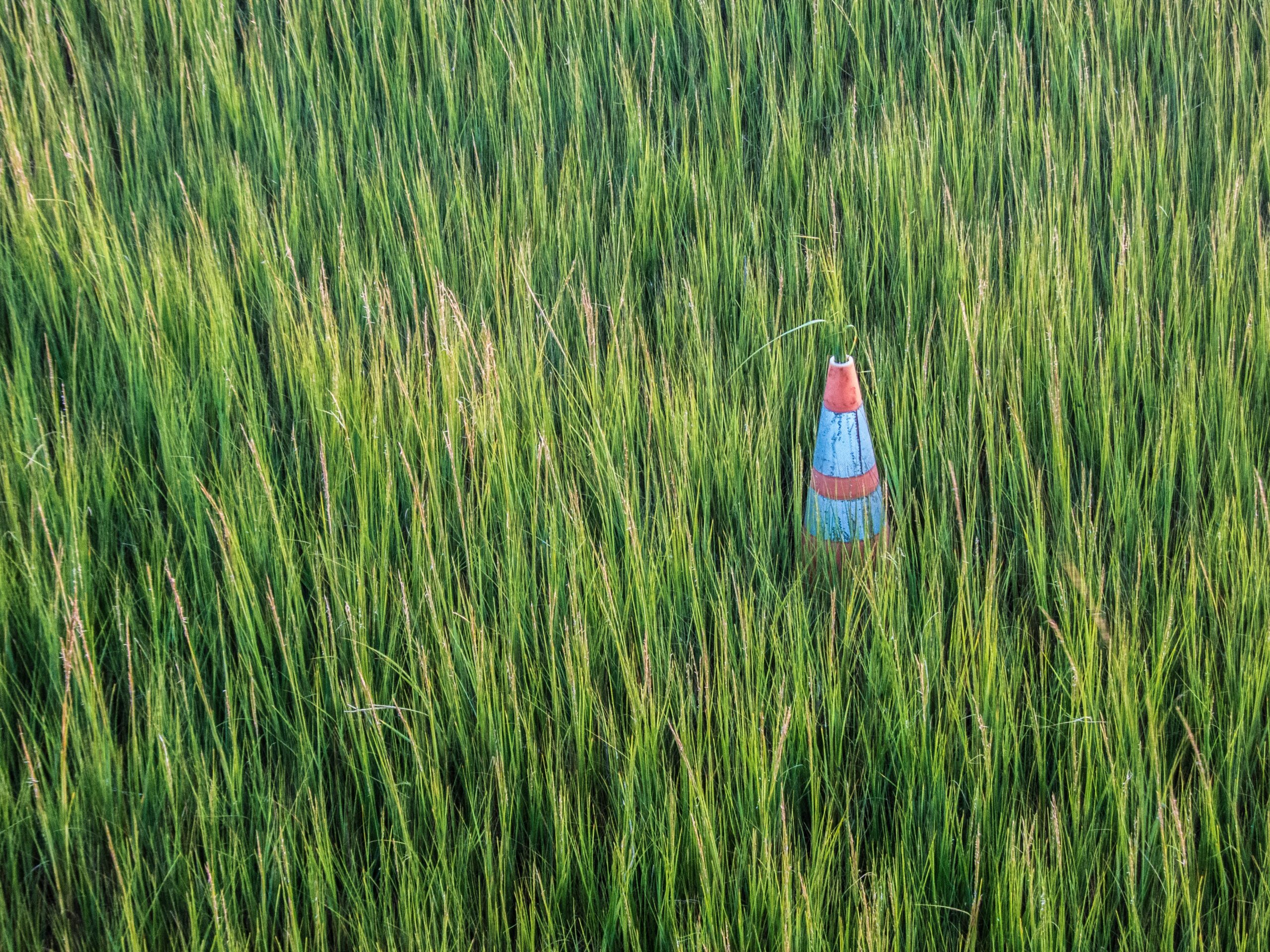
What happens to old road cones?
Every year, thousands of road cones come to the end of their useful life. The good news is, because they’re made out of PVC (a thermoplastic), they can be shredded and used to make new traffic cones.
Here’s how Proline Plastics does it.
Just drop your old cones back to us and we’ll make sure they don’t go to waste.
Fun facts about traffic cones
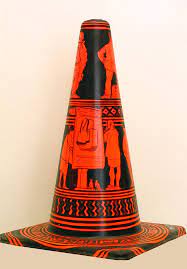
Artwork
Greek artist Yianni Nomiko uses paint and road cones to create a series of traffic cone artworks. His creative works feature scenes of city life, but the styles painted onto the cones are based on the pottery designs of the renowned Red-figure Vases of Classical Greece. The humble road cone therefore becomes more than just a modern utility as it proudly models an artwork style from over 2,500 years ago.
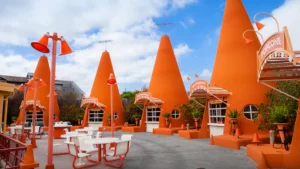 Movies
Movies
The Disney movie “Cars” features the Cozy Cone Motel – a motel for cars where all the units are shaped like oversized traffic cones. The cone fun doesn’t end there, with the fictional small town of ‘Cars Land’ showcasing cone stalls that serve ‘i-cone-ic’ treats such as popcorn and ice-cream *ahem* cones.
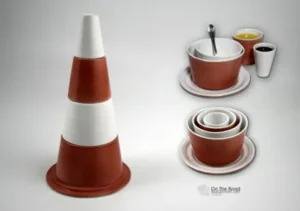 Breakfastware
Breakfastware
Just when you thought traffic cones couldn’t get anymore iconic, a quirky breakfast set pops into the market. French designer Pierre Lescop created his ‘On the Road’ ceramic breakfast set ‘On the Road’ has white and orange sections that form an espresso cup, juice glass, tea cup, bowl and plate; everything you need to prepare and serve a breakfast. When washed and dried the sections reassemble into—a road cone.
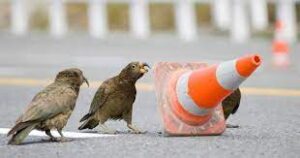 Keas at work
Keas at work
New Zealand’s Kea, the world’s only alpine parrot, have a reputation for their intelligence – and for their destructive behaviour, including pulling soft rubber parts off cars.
It seems they have found road cones equally intriguing, and it was roadside cameras that finally caught them in the act of shifting road cones carefully laid out by roadworks teams.
But what do you do when a native bird thinks road cones exist solely for their entertainment?
You set them up with their own gym!
Yes, it’s true. ‘Kea Gyms’ are officially a thing right here in New Zealand. Equipped with ladders, spinning flotation devices, swings and climbing frames, these carefully designed ‘gyms’ are intended to keep the birds out of mischief and, hopefully, away from traffic, forestry equipment, and of course the ever-present road cones.
Why orange road cones work
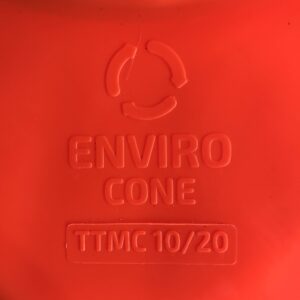 Love ‘em or hate ‘em, there’s no denying that traffic cones are a versatile way to attract attention.
Love ‘em or hate ‘em, there’s no denying that traffic cones are a versatile way to attract attention.
They can be used instantly in a diverse range of foot and vehicle traffic situations, and they don’t require power, constant maintenance or babysitting.
It really is one of the simplest safety concepts around!
Their hollow, upside down ice-cream cone shape makes them eye-catching but also stable on their bases, helping them stand firm and resistant to poor weather. Traffic cones are wonderfully versatile, which is perfect when you need to guide vehicles, equipment or humans along a route.
Their conical structure means traffic cones are super easy to stack, store and move around. And they can be manufactured in large numbers at a low cost – probably why there are an estimated 140 million orange cones dotted around the world!
Their design has been tweaked over the years – and in some cases technologically advanced – and they differ in style from country to country.
But the fact still remains that traffic cones work brilliantly. As a temporary traffic control measure, they really take the cake.
A little bit of road cone history
 So what’s the story behind this genius invention?
So what’s the story behind this genius invention?
In 1943, a painter working for the Los Angeles Streets Department needed a way to keep cars away from wet paint on the road. At the time, barriers used to protect fresh road markings were often made of concrete.
Not exactly versatile or quick!
Sometimes wooden tripods were set up as a visual warning of road works, but the tripods were too thin and unstable. Difficult to see, they were easily broken. They also had to be assembled for each project and were bulky to store.
Frustrated by the inefficiency, Charles Scanlon came up with an idea for a flexible material device. One that would be lighter to move, would spring back up if accidentally run over, and wouldn’t cause damage to vehicles.
(On that note, imagine accidentally hitting the clunky, heavy-duty road barriers Charles was dealing with! No springing back from that fated concrete kiss…)
Anyway, our hero got busy inventing.
His first version saw him cutting up old tyres and joining the strips to make a hardy yet pliable barrier.
He kept at it, refining and adjusting, and in 1943 Charles Scanlon patented the ‘Safety Marker’: the first conical road marker which had the recognisable features of today’s traffic cones. He made it with a heavy base so it could remain upright and rebound from impact, and he included a ‘donut hole’ on top and little base feet for easy grabbing and stacking.
By the 1950s, road cones were rising in use, directing direct traffic and protecting workers on US roads and UK roads. Today, traffic cones can be seen virtually everywhere around the world, and most government agencies (including New Zealand’s) now publish precise specifications for their manufacture and usage of the useful orange ice-cream.
In fact, we use this inverted orange ice-cream practically everywhere. On construction sites, along streets, to mark parking areas, in airports and malls, on our local sports fields – even corridors and hallways utilize them for large-scale events.
And all because one ingenious painter – driven by frustration and a desire to fix a generic problem – revolutionized road works’ equipment forever!
Traffic cones for sale
- Buy road cones for $41 each
- NZ made, in Auckland
- NZTA TTMC/CoPTTM compliant
- 900mm high hi vis orange traffic cones
Road cones for hire in Auckland
- From $3 per day event or traffic cone hire
- From $5 for 3 days
- Great for events, parking, or construction sites
*all prices incl. GST
